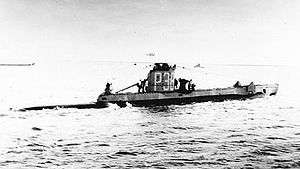HMS P38 (1941)
 | |
| History | |
|---|---|
| Name: | HMS P38 |
| Builder: | Vickers Armstrong, Barrow-in-Furness |
| Laid down: | 2 September 1940 |
| Launched: | 9 July 1941 |
| Commissioned: | 17 October 1941 |
| Out of service: | 23 February 1942 |
| Homeport: | Malta |
| Fate: | Sunk, 23 February 1942 |
| General characteristics | |
| Class and type: | U-class submarine |
| Displacement: |
|
| Length: | 58.22 m (191 ft) |
| Beam: | 4.90 m (16 ft 1 in) |
| Draught: | 4.62 m (15 ft 2 in) |
| Propulsion: |
|
| Speed: |
|
| Complement: | 27-31 |
| Armament: |
|
HMS P38 was a Royal Navy U-class submarine built by Vickers-Armstrong at Barrow-in-Furness.
Career
P38 had a short-lived career with the Royal Navy. Commissioned in October 1941, she was assigned to operate with the 10th Flotilla based in Malta in the Mediterranean in January 1942, under the command of Lieutenant Rowland Hemingway DSC, RN.
On her first patrol she sank the Italian merchant ship Ariosto of 4,116 tons off Cape Afrika, Tunisia on 15 February 1942. 138 Allied prisoners of war aboard were lost. This was the only successful attack by P38.
Sinking
P38 left Malta on 16 February 1942, to intercept a very important large supply convoy for Axis forces off Tripoli, Libya. By 23 February, she was in position as the group of ships approached. Amongst them was the Italian torpedo boat Circe, equipped with German sonar and depth charge throwers. At 08:14 British time (10:14 Italian time), Circe reported a sonar contact at 1,800m with a submarine and that she was turning in to attack, ordering the convoy to turn to port. A periscope was sighted but was quickly replaced by bubbles as the submarine dived, realising it had been spotted.
Shortly after 10:32 (Italian time), following a single attack in which all depth charges were dropped by Circe, P38 rose only to sink immediately again. At 10:40 (Italian time), after further attacks with depth charges and machine guns by the escorts Usodimare and Pessagno, as well as aircraft, during which one Italian rating was killed by friendly fire, P38 rose stern first out of the water, her propellers still turning, steering planes set to surfacing, before crashing back beneath the waves at a bow-down angle of 40 degrees. A large patch of oil appeared on the surface as well as debris and human remains, clear evidence of the submarine’s destruction. P 38 was sunk in 350 metres of water in position 32 degrees 48 minutes north and 14 degrees 58 minutes east some 90 nautical miles (170 km) east of Tripoli, off Cape Misuratha. There were no survivors from her complement of 32.
References
- Royal, Navy (1955). Naval Staff History - Submarines Vol. II Operations in the Mediterranean. Unpublished.
- "HMS P 38". uboat.net.
- "P32 to P222". British submarines of World War II.
- "Submarine losses 1904 to present day". RN Submarine Museum, Gosport.
- Colledge, J. J.; Warlow, Ben (2006) [1969]. Ships of the Royal Navy: The Complete Record of all Fighting Ships of the Royal Navy (Rev. ed.). London: Chatham Publishing. ISBN 978-1-86176-281-8. OCLC 67375475.
- Hutchinson, Robert (2001). Jane's Submarines: War Beneath the Waves from 1776 to the Present Day. London: HarperCollins. ISBN 978-0-00-710558-8. OCLC 53783010.
- Wingate, John. The Fighting Tenth: The Tenth Submarine Flotilla and the Siege of Malta. Pen & Sword. 1991. ISBN 978-0-85052-891-6